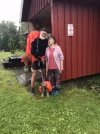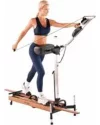- Time of past OR future Camino
- Most years since 2012
Since many people are seriously hoping for a walk in 2021, I'm starting this thread on training for the Camino.
Walking is almost always very good for you, whether or not you get to Spain, so there is every reason to build it into your life style. Now. But walking is slow - typically 3-6 km/h - so it can be hard to find the time for it. That's why I suggest setting goals that are realistic for your circumstances.
I am 72 and moderately fit. My target is to walk 40-50 km/week all year, and perhaps increase to 75 km about 6 weeks before a Camino, and ease off for the last week. Who has time for more? You should toss in an occasional day with 25 km, then perhaps 2 days in a row at 25 km in order to see how you do, but not every day. Similar you might add in a hill or two. But truthfully, I don't, and I just go up the hills in Spain very very slowly.
A few months of training gives you the chance to test and perfect your foot wear - that would be a separate thread. But for me, training is needed in part to sort out my shoes, socks, and adjustments to my custom orthotics. They are quite important to my walking comfort.
A couple of months before your Camino, do a 25-km day with your full backpack and all your exact planned walking clothes - on a clear day and on a rainy day. That's important because you'll find that the particular belt buckle catches on your pack strap, or your sun hat keeps brushing against the top of your pack, or rain drips from your hood onto your glasses, or your phone is too hard to get out of your pocket quickly, or your water bottle is inaccessible, etc. If you don't discover those annoyances at home, you will discover them by day 2 on the camino when it is harder to fix them.
Your body needs to be comfortable walking for hours, several days in a row, and you want the stamina to walk 25 km or so without needing bed rest the next day. Keep walking so that it feels completely natural, but don't over train.
Everybody takes a different approach to their personal routines. What are yours?
Walking is almost always very good for you, whether or not you get to Spain, so there is every reason to build it into your life style. Now. But walking is slow - typically 3-6 km/h - so it can be hard to find the time for it. That's why I suggest setting goals that are realistic for your circumstances.
I am 72 and moderately fit. My target is to walk 40-50 km/week all year, and perhaps increase to 75 km about 6 weeks before a Camino, and ease off for the last week. Who has time for more? You should toss in an occasional day with 25 km, then perhaps 2 days in a row at 25 km in order to see how you do, but not every day. Similar you might add in a hill or two. But truthfully, I don't, and I just go up the hills in Spain very very slowly.
A few months of training gives you the chance to test and perfect your foot wear - that would be a separate thread. But for me, training is needed in part to sort out my shoes, socks, and adjustments to my custom orthotics. They are quite important to my walking comfort.
A couple of months before your Camino, do a 25-km day with your full backpack and all your exact planned walking clothes - on a clear day and on a rainy day. That's important because you'll find that the particular belt buckle catches on your pack strap, or your sun hat keeps brushing against the top of your pack, or rain drips from your hood onto your glasses, or your phone is too hard to get out of your pocket quickly, or your water bottle is inaccessible, etc. If you don't discover those annoyances at home, you will discover them by day 2 on the camino when it is harder to fix them.
Your body needs to be comfortable walking for hours, several days in a row, and you want the stamina to walk 25 km or so without needing bed rest the next day. Keep walking so that it feels completely natural, but don't over train.
Everybody takes a different approach to their personal routines. What are yours?




























